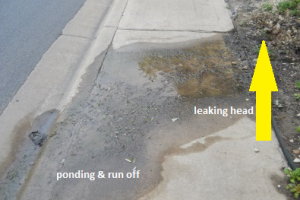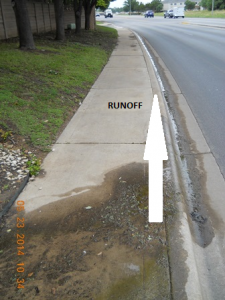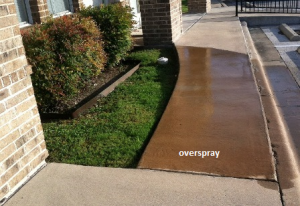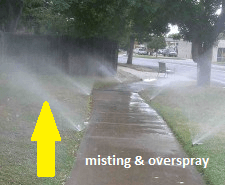Are you are aware of by now, the City has been in Stage 1 of our Drought Contingency Plan (DCP) since October 2013. We’re still in them, still Stage 1. At the beginning of the month, we started increasing enforcement of the restrictions and water waste by putting some signage around town, leaving door-hangers on homes where we’ve seen non-compliance, and sending postcards out to others regarding problems with water waste, watering on the wrong day, and other things. So, it’s easy to understand what day you can water your yard on, and it’s very easy to figure out not to water during the heat of the day …but what is water waste?
…but what is water waste?
To put it simply, water waste is just that–wasted water. Water that isn’t used for any purpose, it just flows or leaves a property without any benefit to that property. There are several things we look for specifically when talking about water waste: broken or leaking heads or valves, runoff, water ponding in a gutter or parking area or street, overspray, and misting. Let’s look at each of them up close.
-
Broken or Leaking heads or valves–this really could be more generalized to include anything broken or leaking water that can be fixed. Broken sprinkler heads are what people typically think of as huge water wasters, but it’s really not the case. Sure, they do use a little more water each minute the system is running with the broken head, it’s really the leaks that are leaking constantly that add up to t
 housands of gallons of water overtime. This could also include the leaky faucet on the outside of the house. The picture at the top right shows a broken head–it’s spraying water straight up into the air rather than low, like the other heads. There’s also high pressure here, a broken head may not always spray up that high. In the second picture, there’s a leaking head that has been leaking for so long there’s algae growing on the sidewalk! Not good. This leak is running 24/7 so is wasting a lot more water than the broken head.
housands of gallons of water overtime. This could also include the leaky faucet on the outside of the house. The picture at the top right shows a broken head–it’s spraying water straight up into the air rather than low, like the other heads. There’s also high pressure here, a broken head may not always spray up that high. In the second picture, there’s a leaking head that has been leaking for so long there’s algae growing on the sidewalk! Not good. This leak is running 24/7 so is wasting a lot more water than the broken head.
-
Water running off property—the same leak as mentioned above can be used again. Runoff is just like it sounds, it’s water running off the property. The water from that leaking sprinkler head is running (flowing) down the street for at least 50 feet into the intersection of the next street. Really, if you’re watering your yard, you want the water to stay on your yard, right? If water is running off, it means you’re watering too long and the soil can’t absorb all the water so you need to reduce how long the sprinkler is running; if you have a sloped yard and the angle is causing the water to run off, same thing, reduce the runtimes and water it multiple times (i.e. run it for 5 minutes once an hour at 3am, 4am, 5am so it would water for a total of 15 min.). If a sprinkler head is turned the wrong way and spraying more onto a hard surface (driveway, sidewalk, street) rather than the yard, that causes runoff too. The head just needs to be adjusted to spray the grass. All can be easily fixed.
-
Water ponding–This is wasteful, water just sitting in a parking lot or street gutter, or sidewalk that is just going to
 evaporate. It’s caused by the same things that cause the runoff, above, and can also be a hazard due to the algae growth of standing water–people could slip and fall on it, bikes going across it could also slip or become unsteady. The standing water can also erode the pavement and break down the streets quicker than with normal wear and tear, causing added costs to the City to repair or replace them.
evaporate. It’s caused by the same things that cause the runoff, above, and can also be a hazard due to the algae growth of standing water–people could slip and fall on it, bikes going across it could also slip or become unsteady. The standing water can also erode the pavement and break down the streets quicker than with normal wear and tear, causing added costs to the City to repair or replace them.
-
Overspray–this is an easy one. It’s simply water that is over spraying the grass and landing in the street, or other impervious surface. The nozzle can be adjusted to reduce how far the water sprays out by turning the little screw on the top of the sprinkler head clockwise. The water that is landing in the street or sidewalk leads to runoff and ponding. In the picture below, the overspray is evident by the wet pavement. The sprinkler heads are behind the shrubs and spraying way out onto the sidewalk.

-
Misting–this is caused by too high water pressure. It’s a waste of water because most of the water is simply floating off into the atmosphere, rather than going down onto your yard. The water droplets are so small, due to the force (the water pressure) pushing them out of the sprinkler nozzle, that the wind then carries them off. The water droplets need to be larger, heavy, to fall down onto your yard. Ideally, the sprinkler psi should be between 30-50psi. If you have high pressure and misting, it can be reduced by installing new sprinkler nozzles with built in pressure regulation or installing a pressure reducing device on the entire system. The City’s efficient irrigation rebate covers both of these ways to control high pressure. In the picture below, the misting is the cloud-like appearance of the water spraying out of the sprinkler head. It shouldn’t be like that, when the sprinkler is running, you should be able to see the individual water drops.
So you can see that a lot of these problems are related and often times caused by each other. It’s easy to fix them with some simple adjusting of sprinkler heads or runtimes (minutes) in most cases. I ask you to make those changes and help save some water and some money!


